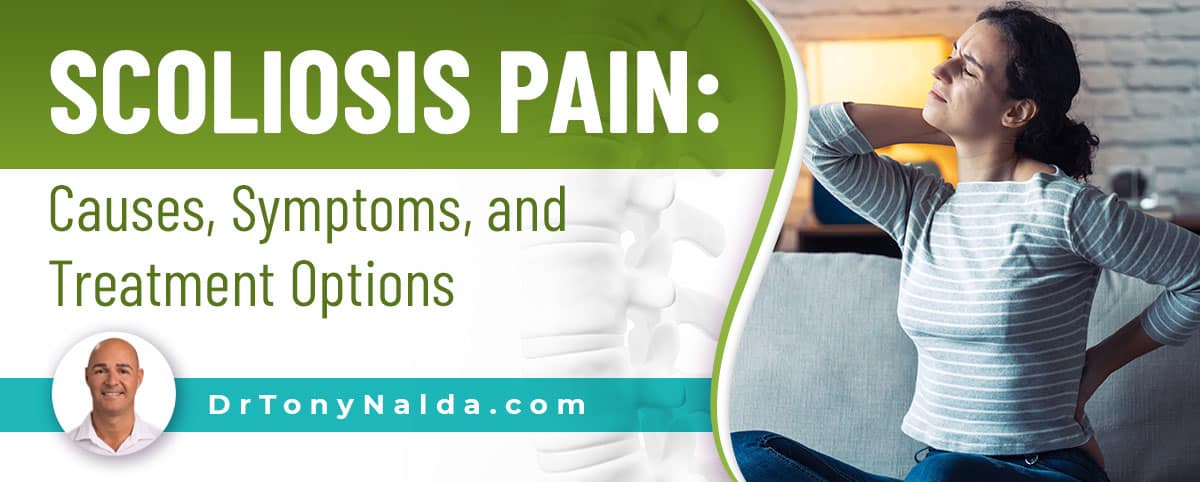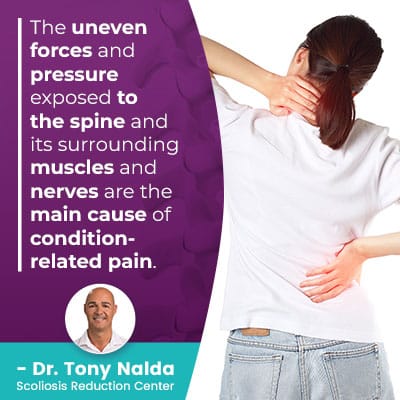Scoliosis Pain: Causes, Symptoms, and Treatment Options

Although scoliosis is a spinal condition, it can affect the body in different ways, from postural deviation to back, muscle, or radicular pain. Continue reading to find out why scoliosis is more painful for adults than adolescents and what can be done about it.
Scoliosis pain will vary from one patient to the next and is shaped by key patient/condition variables. Scoliosis is more commonly painful for adults than children and adolescents, and this is due to compression. The best remedy for scoliosis pain is proactive treatment.
Before getting to the specifics of scoliosis pain, let’s first touch on what’s happening inside the body of a person with scoliosis.
Table of Contents
Understanding Scoliosis
Scoliosis is a structural spinal condition, but its effects can be felt throughout the body.
Not only does the spine work in tandem with the brain to form the body’s central nervous system, but it also gives the body structure, protects vital organs, and allows us to stand upright and engage in flexible movement.
Scoliosis involves the development of an unnatural sideways spinal curve, with rotation and a minimum Cobb angle measurement of 10 degrees.
A patient’s Cobb angle is measured by drawing intersecting lines from the tops and bottoms of the most-tilted vertebrae, and the resulting angle is expressed in degrees.
A scoliotic spine doesn’t just bend unnaturally to the side but also twists, and it’s the rotational component that makes scoliosis a 3-dimensional condition.
Scoliosis is a highly-variable condition that can range from mild to moderate and severe to very severe, so what one patient experiences isn’t indicative of what another will. In addition, scoliosis is progressive, meaning it’s in its very nature to worsen over time, especially if left untreated.
Mild scoliosis can easily progress to moderate, severe, or very severe; the only way to counteract the condition’s progressive nature is to treat it proactively.
It’s a patient’s Cobb angle that classifies conditions based on severity and tells me how far out of alignment a scoliotic spine is:
- Mild scoliosis: Cobb angle measurement of between 10 and 25 degrees
- Moderate scoliosis: Cobb angle measurement of between 25 and 40 degrees
- Severe scoliosis: Cobb angle measurement of 40+ degrees
- Very-severe scoliosis: Cobb angle measurement of 80+ degrees
When it comes to scoliosis pain, we’re talking about pain that’s caused by the introduction of uneven forces that can cause postural deviation, back pain, radicular pain, and muscle pain.
There is also an important difference in scoliosis pain based on patient age, so let’s start there.
Scoliosis Pain and Adolescent Idiopathic Scoliosis
In addition to different severity levels, there are different condition types, with the most prevalent type of scoliosis being adolescent idiopathic scoliosis (AIS), diagnosed between the ages of 10 and 18.
 The idiopathic designation means it’s not clearly associated with a single-known cause; idiopathic scoliosis is the most common type, accounting for approximately 80 percent of known diagnosed cases.
The idiopathic designation means it’s not clearly associated with a single-known cause; idiopathic scoliosis is the most common type, accounting for approximately 80 percent of known diagnosed cases.
The remaining 20 percent are associated with known causes: neuromuscular, congenital, degenerative, and traumatic scoliosis.
Now, in children and adolescents, scoliosis isn’t commonly described as painful, and that’s due to growth and compression.
In patients who are still growing and have not yet reached skeletal maturity, their spines are experiencing a constant lengthening motion that counteracts the compressive force of the unnatural spinal curve.
The uneven forces and pressure exposed to the spine and its surrounding muscles and nerves are the main cause of condition-related pain.
So as scoliosis doesn’t become compressive until skeletal maturity has been reached, children and adolescents don’t tend to find scoliosis as painful as older patients for whom it’s become a compressive condition.
That being said, adolescents do report issues with muscle pain related to uneven wear, strain, and muscle imbalance.
While the main symptom of scoliosis in children and adolescents is a postural deviation that disrupts the body’s overall symmetry, in adults, it’s pain.
Scoliosis Pain and Adult Scoliosis
As scoliosis becomes compressive in adulthood, the number-one symptom in adults is pain, and that can take the form of localized back pain or radicular pain felt throughout the body.
As the spinal canal is home to 31 pairs of spinal nerves, when the spine is unnaturally curved, it exposes the nerves within to uneven pressure, which can cause them to become irritated, inflamed, compressed, or impinged.
When a nerve is irritated, compressed, or damaged, it doesn’t function properly. As nerves are like branches on a tree, fanning off in multiple directions, pain can be felt anywhere along an affected nerve’s pathway, which can be extensive.
For people with lumbar scoliosis, sciatica is a common complication as the sciatic nerve starts in the lower back and extends down the buttock, leg, and into the foot.
If the lumbar spine is unnaturally curved and exposes the sciatic nerve, either at its root, or anywhere along its pathway, to uneven pressure, it can become pinched, irritated, inflamed, or compressed, impairing its function.
In fact, most adults come in to see me for a diagnosis because of radicular pain felt in the arms, legs, and feet; radicular pain can feel like sharp shooting pains, dull throbbing sensations, numbness, tingling, or electric shock-like pains.
Localized back pain can feel like the back is tight and stiff or like it’s being weighed down on one side. As a scoliotic curve gets bigger, the spine becomes increasingly rigid. As this happens, the muscles that surround the spine can become painful as they struggle to support the unnaturally-curved spine.
Not only do the muscles that surround the spine become strained as they try to support it, they are also exposed to uneven pressure and forces, which can lead to muscle imbalance. Muscles on one side of the body can be stiff and tight, while muscles on the other side of the body are weak.
Muscles that are stiff and tight need to be stretched, while weak muscles need to be strengthened.
So while scoliosis isn’t generally as painful for children and adolescents as it can be for adults, there are other kinds of pain/discomfort associated with the condition.
Scoliosis and Headaches
In addition to back/radicular pain, and related muscle pain, scoliosis is also associated with headaches that can reach migraine status.
Scoliosis can cause a disruption to the flow of cerebrospinal fluid (CSF) in and around the spinal cord and brain.
The CSF helps cushion the spinal cord and brain from impact, helps remove waste products from the brain, and keeps the central nervous system working optimally.
If scoliosis causes a disruption to the flow of CSF and causes lower levels in and around the brain, headaches that can reach migraine status can develop.
So now that we know how scoliosis pain is related to uneven forces and compression, affecting the back, muscles, and areas throughout the body, what are the best treatment options for pain management?
Scoliosis Pain Treatment Options
 There are different factors that play into how painful a person is likely to find their condition, the main ones being patient age, condition type, severity, curvature location, and the angle of trunk rotation.
There are different factors that play into how painful a person is likely to find their condition, the main ones being patient age, condition type, severity, curvature location, and the angle of trunk rotation.
In general, the more severe a condition is, and the more twisted the spine is (rotational component), the more painful it is likely to be.
When it comes to pain management, there is a big difference between addressing pain as a symptom or addressing its underlying cause: the condition itself.
As a structural condition, it’s the underlying structural nature that, first and foremost, has to be impacted with treatment, and this can be done through conservative treatment that uses chiropractic care to work towards a curvature reduction.
Through a series of precise manual adjustments and chiropractic techniques, I can work towards adjusting the position of the most-tilted vertebrae at the curve’s apex back into alignment with the rest of the spine.
Once I start to see those types of structural results, I shift the focus to increasing core strength, so the spine is optimally supported, and corrective bracing can help augment corrective results achieved through other treatment disciplines by pushing the spine into a corrective position.
Custom-prescribed exercises can help establish a home-rehabilitation program for sustainable long-term results.
Here at the Scoliosis Reduction Center, I believe in starting proactive treatment as close to the time of diagnosis as possible so increasing condition severity, escalating symptoms, and the need for more invasive treatment in the future can be avoided.
Through integrating condition-specific chiropractic care, in-office therapy, corrective bracing, and custom-prescribed home exercises, conditions can be impacted on every level, and as the underlying cause of scoliosis pain (the condition itself) is being addressed, pain is being treated proactively and effectively.
Conclusion
When it comes to understanding scoliosis pain, it’s all about the condition’s uneven forces.
The main symptom of scoliosis in adolescents is a postural deviation that involves a disruption to the body’s overall symmetry, and while adults also experience postural changes, their main symptom is pain.
Scoliosis becomes compressive in adulthood, which is why the spine and its surrounding muscles and nerves become vulnerable to the condition's uneven forces once skeletal maturity has been reached.
Scoliosis pain is shaped by the patient’s age and overall health, condition type (cause), severity, curvature location, and the angle of trunk rotation.
So can scoliosis be painful? Yes, it can be, although just because it is for one patient doesn’t mean it will be for another.
The best remedy for scoliosis pain is a proactive treatment that strives to, first and foremost, impact the condition on a structural level and then focuses on increasing core strength so the spine is optimally supported by its surrounding muscles.
Dr. Tony Nalda
DOCTOR OF CHIROPRACTIC
After receiving an undergraduate degree in psychology and his Doctorate of Chiropractic from Life University, Dr. Nalda settled in Celebration, Florida and proceeded to build one of Central Florida’s most successful chiropractic clinics.
His experience with patients suffering from scoliosis, and the confusion and frustration they faced, led him to seek a specialty in scoliosis care. In 2006 he completed his Intensive Care Certification from CLEAR Institute, a leading scoliosis educational and certification center.
About Dr. Tony Nalda
 Ready to explore scoliosis treatment? Contact Us Now
Ready to explore scoliosis treatment? Contact Us Now





